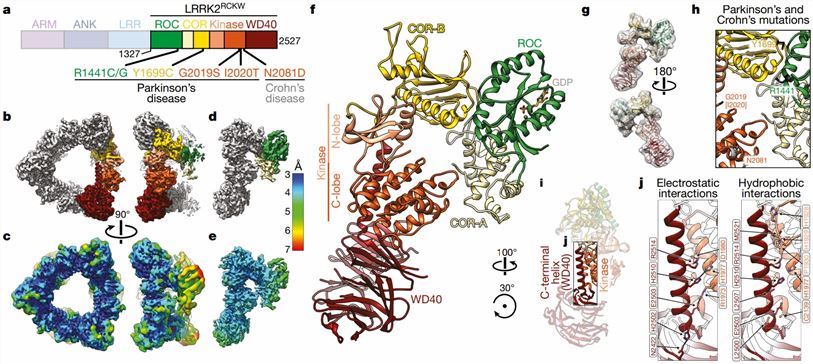What is LRRK2 Protein
The LRRK2 protein, short for leucine-rich repeat kinase 2, has been the focus of numerous studies due to its multifaceted roles, impact on disease, and potential applications in biomedical research.
The LRRK2 protein, encoded by the PARK8 gene on chromosome 12, is at the forefront of molecular research due to its complex structure and multifunctional roles. LRRK2 has domains such as leucine-rich repeats, a Roc GTPase domain, a COR domain, a kinase domain, and a WD40 repeat domain, and is primarily expressed in the brain, particularly in regions associated with motor control.
 Figure 1. Cryo-EM structure of LRRK2RCKW (Deniston, C.K., et al. 2020)
Figure 1. Cryo-EM structure of LRRK2RCKW (Deniston, C.K., et al. 2020)The Function of LRRK2 Protein
Understanding the physiological function of LRRK2 is critical to understanding its role in health and disease. LRRK2's involvement in vesicle trafficking, autophagy, and cytoskeletal regulation demonstrates its multifunctionality. Notably, LRRK2 regulates autophagy and plays a crucial role in maintaining cellular homeostasis by coordinating the degradation and recycling of cellular components. This insight into LRRK2's function highlight its potential impact on cellular health.
LRRK2-Related Diseases
The association between LRRK2 and neurodegenerative disorders, particularly Parkinson's disease (PD), is a focus of research. Mutations in the LRRK2 gene are found in a large proportion of familial Parkinson's disease cases, suggesting a direct link between LRRK2 dysfunction and neurodegeneration. In addition to PD, LRRK2 mutations have been linked to Crohn's disease, expanding the range of diseases affected by this enigmatic protein.
LRRK2 Related Signaling Pathways
Deciphering the signaling pathways associated with LRRK2 will help reveal its complex molecular interactions. The mitogen-activated protein kinase (MAPK) pathway plays a key role in LRRK2 signaling. The kinase domain of LRRK2 activates the MAPK cascade, affecting key cellular responses such as proliferation, differentiation, and apoptosis. Furthermore, the effects of LRRK2 on mitochondrial dynamics underscore its role in maintaining cellular energy balance, making it a key player in cellular homeostasis.
Applications of LRRK2 in Biomedical Research
An emerging field of biomedical research has identified promising applications for LRRK2. Inhibition of LRRK2 kinase activity offers a potential therapeutic strategy for neurodegenerative disorders, particularly Parkinson's disease. Small molecule inhibitors targeting the kinase domain of LRRK2 have shown promise in preclinical studies, raising hope for the development of disease-modifying therapies. Furthermore, LRRK2 serves as a potential biomarker, providing valuable insights into disease progression and providing diagnostic and prognostic utility by monitoring its levels and activity.
With its complex structure and diverse functions, LRRK2 protein has become the key to unlocking the mysteries of neurodegenerative diseases and cell homeostasis. From its role in autophagy to its association with diseases such as Parkinson's disease and Crohn's disease, LRRK2 continues to fascinate researchers because of its complex involvement in cellular processes. Understanding the signaling pathways associated with LRRK2 will not only provide insights into its normal function but also reveal potential therapeutic targets for diseases associated with LRRK2 dysfunction. As the field of biomedicine advances, the use of LRRK2 inhibitors and their potential as biomarkers has opened new avenues for targeted intervention and diagnostic precision, bringing us one step closer to harnessing the full potential of this protein.
Recommended Products for LRRK2 Protein
| Cat.# | Species | Product name | Source (Host) | Tag |
|---|---|---|---|---|
| LRRK2-109H | Human | Active Recombinant Human LRRK2 (G2385R), GST-tagged, Active | Sf9 Insect Cell | GST |
| LRRK2-108H | Human | Active Recombinant Human LRRK2 (G2019S), GST-tagged, Active | Sf9 Insect Cell | GST |
| LRRK2-110H | Human | Active Recombinant Human LRRK2 (I2020T), GST-tagged, Active | Sf9 Insect Cell | GST |
| LRRK2-33H | Human | Active Recombinant Human LRRK2 Protein, FLAG-tagged | Mammaliaan Cells | FLAG |
| LRRK2-115H | Human | Active Recombinant Human LRRK2 (Y1699C) Protein, GST-tagged, Active | Insect Cell | GST |
| LRRK2-117H | Human | Active Recombinant Human LRRK2 Protein, GST-tagged, Active | Insect Cell | GST |
| LRRK2-114H | Human | Active Recombinant Human LRRK2 (R1441H) Protein, GST-tagged, Active | Insect Cell | GST |
| LRRK2-111H | Human | Active Recombinant Human LRRK2 (D1994A) Protein, GST-tagged, Active | Insect Cell | GST |
| LRRK2-35HCL | Human | Recombinant Human LRRK2 HEK293T cell lysate | HEK293 | Myc/DDK |
| Lrrk2-1555M | Mouse | Recombinant Mouse Lrrk2 protein, His & GST-tagged | E.coli | His/GST |
Reference
- Deniston, C.K., et al. Structure of LRRK2 in Parkinson's disease and model for microtubule interaction. Nature. 2020, 588: 344–349.

